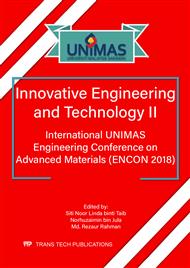[1]
J. George, M.S. Sreekala, S. Thomas, A review on interface modification and characterization of natural fiber reinforced plastic composites, Polym. Eng. Sci. 41 (2001) 1471-1485.
DOI: 10.1002/pen.10846
Google Scholar
[2]
J.A. Khan, M.A. Khan, R. Islam, Effect of mercerization on mechanical, thermal and degradation characteristics of jute fabric-reinforced polypropylene composites, Fib. Polym. 13 (2012) 1300-1309.
DOI: 10.1007/s12221-012-1300-8
Google Scholar
[3]
M.W. Dewan, M.K. Hossain, M. Hosur, S. Jeelani, Thermomechanical properties of alkali treated jute-polyester/nanoclay biocomposites fabricated by VARTM process, J. Appl. Polym. Sci. 128 (2013) 4110-4123.
DOI: 10.1002/app.38641
Google Scholar
[4]
A.K. Bledzki, S. Reihmane, J. Gassan, Properties and modification methods for vegetable fibers for natural fiber composites, J. Appl. Polym. Sci. 59 (1996) 1329-1336.
DOI: 10.1002/(sici)1097-4628(19960222)59:8<1329::aid-app17>3.0.co;2-0
Google Scholar
[5]
X. Li, L.G. Tabil, S. Panigrahi, Chemical treatments of natural fiber for use in natural fiber-reinforced composites: A Review, J. Polym. Environ. 15 (2007) 25-33.
DOI: 10.1007/s10924-006-0042-3
Google Scholar
[6]
D.A. Kumar and A.L. Naidu, A study on different chemical treatments for natural fiber reinforced composites, Int. J. Mech. Product. Eng. Res. Develop. 8 (2018) 143-152.
Google Scholar
[7]
H. Wang, H. Memon, E.A.M. Hassan, M.S. Miah, M.A. Ali, Effect of jute fiber modification on mechanical properties of jute fiber composite, Materials 12 (2019) 1-11.
DOI: 10.3390/ma12081226
Google Scholar
[8]
P.K. Aggarwal, N. Raghu, A. Karmarkar, S. Chuahan, Jute-polypropylene composites using m-TMI-grafted-polypropylene as a coupling agent, Mater. Design 43 (2013) 112-117.
DOI: 10.1016/j.matdes.2012.06.026
Google Scholar
[9]
J.A. Brydson, Plastic materials, 3rd edition, Newnes Butterworths, London, (1975).
Google Scholar
[10]
L. Mohammed, M.N.M. Ansari, G. Pua, M. Jawaid, M.S. Islam, A review on natural fiber reinforced polymer composite and its applications, Int. J. Polym. Sci. 2015 (2015) 1-15.
DOI: 10.1155/2015/243947
Google Scholar
[11]
E. Winkle, M.J. Cowling, S.A. Hashim, E.M. Smith, What can adhesives offer to Shipbuilding? J. Ship Product. 7 (1991) 137-152.
DOI: 10.5957/jsp.1991.7.3.137
Google Scholar
[12]
R.F. Gibson, Principles of Composite Materials Mechanics, McGraw Hill, New York, (1994).
Google Scholar
[13]
A.S. Singha and V.K. Thakur, Morphological, thermal and physicochemical characterization of surface modified pinus fibers, Int. J. Polym. Anal. Charact. 14 (2009) 271-289.
DOI: 10.1080/10236660802666160
Google Scholar
[14]
F. Khan and S.R. Ahmad, Chemical modification and spectroscopic analysis of jute fiber, Polym. Degrad. Stab. 52 (1996) 335-340.
Google Scholar
[15]
T.W. Frederick and W. Norman, Natural fibers plastics and composites, Kluwer Academic Publishers, New York, (2004).
Google Scholar
[16]
M.M. Haque, M. Hasan, M.S. Islam, M.E. Ali, Physico-mechanical properties of chemically treated palm and coir fiber reinforced polypropylene composites, Biores. Technol. 100 (2009) 4903-4906.
DOI: 10.1016/j.biortech.2009.04.072
Google Scholar
[17]
M.F. Hossen, S. Hamdan, M.R. Rahman, M.M. Rahman, F.K. Liew, J.C.H. Lai, Effect of fiber treatment and nanoclay on the tensile properties of jute fiber reinforced polyethylene-clay nanocomposites, Fib. Polym. 16 (2015) 479-485.
DOI: 10.1007/s12221-015-0479-x
Google Scholar
[18]
M.A. Khan, M.M. Hassan and L.T. Drzal, Effect of 2-hydroxyethyl methacrylate (HEMA) on the mechanical and thermal properties of jute-polycarbonate composite, Compos. A: Appl. Sci. Manuf. 36 (2005) 71-81.
DOI: 10.1016/s1359-835x(04)00178-2
Google Scholar
[19]
E. Sinha and S.K. Rout, Influence of fiber-surface treatment on structural, thermal and mechanical properties of jute, J. Mater. Sci. 43 (2008) 2590-2601.
DOI: 10.1007/s10853-008-2478-4
Google Scholar
[20]
P. Ganan, R. Zulunga, A. Restrepo, J. Labidi, I. Mondragon, Plantain fiber bundles isolated from colombian agro-industrial restudies," Biores. Technol. 99 (2008) 486-491.
DOI: 10.1016/j.biortech.2007.01.012
Google Scholar
[21]
D. Ray, B.K. Sarkar, A.K. Rana, N.R. Bose, Effect of alkali treated jute fibers on composite properties, Bull. Mater. Sci. 24 (2001) 129-135.
DOI: 10.1007/bf02710089
Google Scholar
[22]
M.K. Hossain, M.W. Dewan, M. Hosur, S. Jeelani, Mechanical performances of surface modified jute fiber reinforced biopol nanophased green composites, Compos. B: Eng. 42 (2011) 1701-1707.
DOI: 10.1016/j.compositesb.2011.03.010
Google Scholar
[23]
Y. Seki, Innovative multifunctional siloxane treatment of jute fiber surface and its effect on the mechanical properties of jute/thermoset composites, Mater. Sci. Eng. A 508 (2009) 247-252.
DOI: 10.1016/j.msea.2009.01.043
Google Scholar
[24]
L.Y. Mwaikambo and M.P. Ansell, Chemical modification of hemp, sisal, jute, and kapok fibers by alkalization, J Appl. Polym. Sci. 84 (2002) 2222-2234.
DOI: 10.1002/app.10460
Google Scholar
[25]
M.F. Hossen, S. Hamdan, M.R. Rahman, M.S. Islam et al., Effect of clay content on the morphological, thermo-mechanical and chemical resistance properties of propionic anhydride treated jute fiber/polyethylene/nanoclay nanocomposites, Measurement 90 (2016) 404-411.
DOI: 10.1016/j.measurement.2016.05.006
Google Scholar
[26]
M.F. Hossen, S. Hamdan, M.R. Rahman, Improved mechanical properties of silane treated jute/polyethylene/clay nanocomposites, Malays. Appl. Biol. 47 (2018) 209-215.
Google Scholar
[27]
K. John and S.V. Naidu, Chemical resistance of sisal/glass reinforced unsaturated polyester hybrid composites, J. Reinf. Plast. Compos. 26 (2007) 373-376.
DOI: 10.1177/0731684406072524
Google Scholar
[28]
M. Jawaid, H.P.S. Abdul Khalil, A.A. Bakar, P.N. Khanam, Chemical resistance, void content and tensile properties of oil palm/jute fiber reinforced polymer hybrid composites, Mater. Design. 32 (2011) 1014-1019.
DOI: 10.1016/j.matdes.2010.07.033
Google Scholar
[29]
Y. Indraja, G.S. Kumar, H.R. Rao, Study of mechanical and chemical properties of biodegradable fibers before and after alkali treatment, J. Inform. Eng. Appl. 4 (2014) 1-5.
Google Scholar


